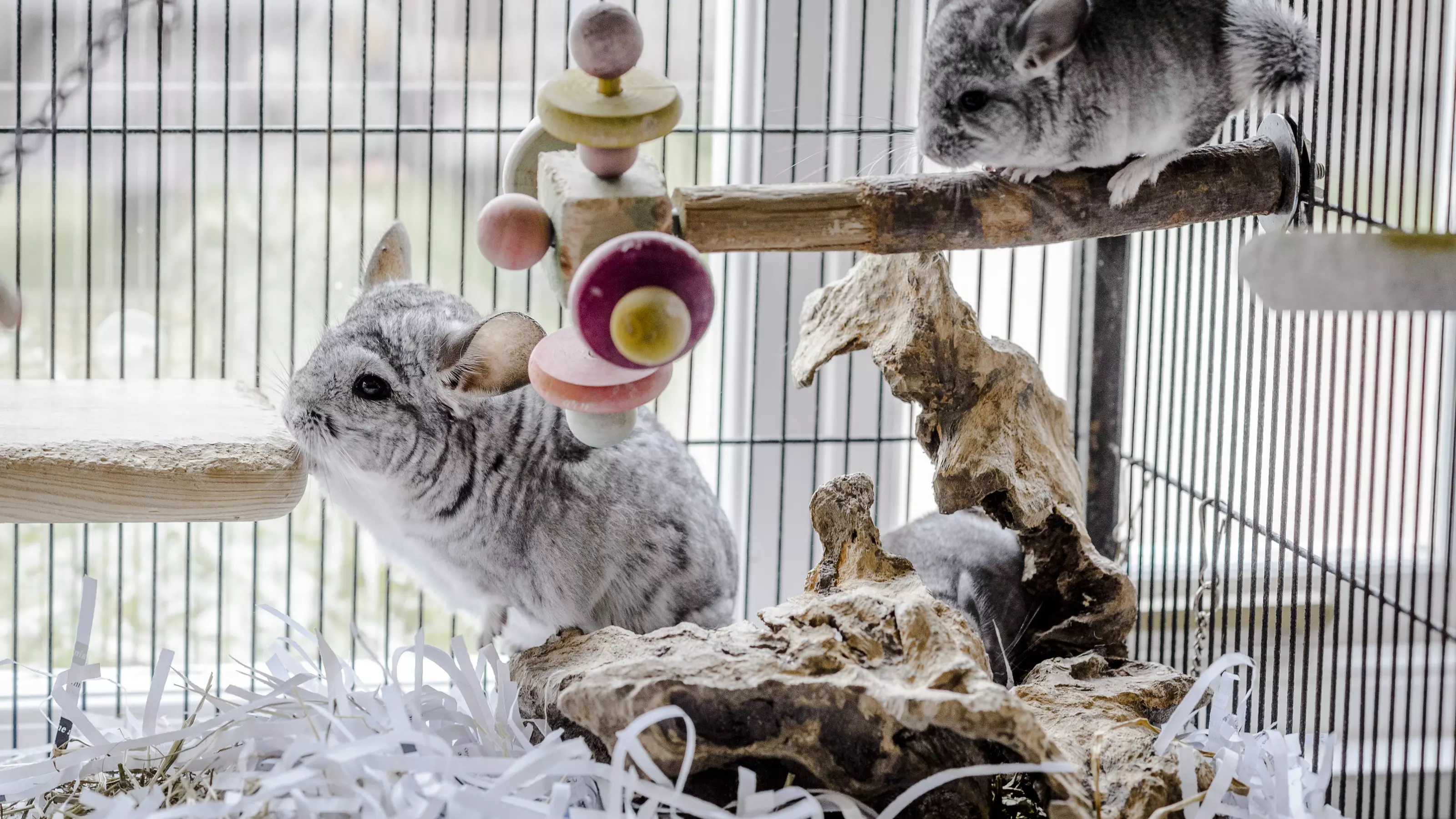
Do you find it tricky to get your chinchilla to come back to its cage when playtime is over? You’re not alone.
Teaching your chinchilla to return on command can make your life easier and keep your furry friend safe. Imagine calling your chinchilla and having it hop right back, no fuss, no stress. You’ll discover simple, effective steps to train your chinchilla to come home willingly.
Keep reading to turn your cage into a place your chinchilla loves—and make your daily routine smoother.

Credit: www.bluecross.org.uk
Choosing The Right Cage
Choosing the right cage plays a key role in teaching chinchillas to return. The cage must be comfortable and safe. It should invite your pet to come back without stress. A well-chosen cage helps build trust and routine. This section explains how to select the best cage for your chinchilla.
Ideal Cage Size
Chinchillas need space to move and jump around. The cage should be at least 24 inches wide, 24 inches deep, and 36 inches tall. Bigger cages provide more room for exercise and toys. Tall cages are better because chinchillas like to jump. A cramped cage can make your pet unhappy and less willing to return.
Safe Cage Materials
Choose cages made from metal or stainless steel. These materials are strong and chew-proof. Avoid plastic cages or ones with wooden bars. Chinchillas chew a lot, and unsafe materials can harm them. Make sure the cage has smooth edges. This prevents injuries and keeps your chinchilla safe.
Cage Placement Tips
Place the cage in a quiet, cool spot. Avoid direct sunlight or drafts. Chinchillas do not like heat or loud noises. Keep the cage away from other pets. This reduces stress and distractions. A calm environment encourages your chinchilla to return willingly.

Credit: www.amazon.com
Building Trust With Your Chinchilla
Building trust with your chinchilla is the first step to teaching it to return to its cage. Trust helps your pet feel safe and comfortable. A chinchilla that trusts you will listen and follow your cues more easily. This bond takes time and patience. Each small action can make a big difference.
Approaching Gently
Always move slowly around your chinchilla. Sudden movements can scare it. Speak softly and avoid loud noises. Let your chinchilla see your hands before touching it. Approach from the side, not from above. This shows you are not a threat. Gentle actions build a sense of safety.
Using Treats Effectively
Treats are great tools to gain your chinchilla’s trust. Choose healthy, chinchilla-safe snacks. Offer treats by hand to encourage closeness. Do not force the treat; wait patiently. Use treats to reward calm behavior near the cage. This helps your chinchilla link the cage with positive feelings.
Consistent Interaction
Spend time with your chinchilla daily. Short, regular sessions work best. Consistency helps your pet learn what to expect. Talk softly and offer treats often. Repeat gentle handling and cage training steps. Over time, your chinchilla will feel more secure. Consistent care builds a strong, trusting bond.
Training Basics
Training a chinchilla to return to its cage takes patience and care. It helps your pet feel safe and comfortable. Start with simple steps to build trust and understanding. Clear communication is key. Let’s explore the basics of training your chinchilla effectively.
Setting A Routine
Chinchillas thrive on routine. Set specific times for play and rest. Bring your chinchilla back to its cage at the same time daily. This habit helps your pet know what to expect. Consistency makes training easier and faster. Keep the environment calm and quiet during these times.
Using Positive Reinforcement
Reward good behavior immediately. Use small treats your chinchilla loves. Praise softly with a calm voice. Rewards encourage your chinchilla to repeat actions. Avoid punishment as it causes fear and confusion. Positive feedback builds trust and makes learning fun.
Recognizing Chinchilla Behavior
Watch your chinchilla’s body language closely. Signs like twitching whiskers or alert ears show curiosity. A relaxed chinchilla will move calmly and explore. Understanding these signals helps you know when your pet is ready to return. Respect their mood to avoid stress during training.
Step-by-step Training Process
Teaching chinchillas to return to their cage takes patience and clear steps. Follow a simple process to help your pet learn quickly. This builds trust and makes handling easier. The process involves using treats, verbal cues, and giving your chinchilla more space over time.
Each step helps your chinchilla understand what you want. Keep training sessions short and positive. This way, your pet stays calm and interested. Here is a step-by-step guide to train your chinchilla effectively.
Luring With Treats
Start by using treats your chinchilla loves. Hold a treat near the cage entrance. Let your chinchilla smell and see it. Slowly move the treat inside the cage. This invites your pet to follow the scent. Reward your chinchilla with the treat once inside. Repeat this several times to build a habit.
Using Verbal Cues
Choose a simple word or phrase for returning to the cage. Say this cue each time you offer a treat. Use a calm and steady voice. Your chinchilla will begin to connect the word with the action. Consistency is key. Always say the same cue before rewarding your pet.
Gradual Freedom Expansion
Give your chinchilla more space to explore outside the cage. Start with a small, safe area. Watch your pet closely while exploring. Call your chinchilla back using the verbal cue and offer a treat. Increase the play area size slowly over days or weeks. This teaches your pet to come back from different distances.
Common Challenges
Teaching chinchillas to return to their cage can be tricky. Many owners face common challenges that slow the training process. Understanding these issues helps keep training calm and steady. Patience and gentle methods are key.
Avoiding Stress
Chinchillas are sensitive animals. Stress can make them afraid of their cage. Loud noises and sudden movements increase stress. Use a soft voice and slow motions. Give your chinchilla time to relax before training.
Handling Reluctance
Some chinchillas do not want to go back inside. They may feel safer outside the cage. Use treats to encourage them gently. Avoid forcing them in. Make the cage a happy place with toys and soft bedding.
Dealing With Distractions
Chinchillas get easily distracted by sounds and sights. Training in a quiet, calm room helps focus. Remove toys or objects that pull their attention away. Keep sessions short to hold their interest.

Credit: infolific.com
Maintaining Training Success
Maintaining training success with chinchillas takes patience and steady effort. Consistent habits help your pet feel safe and ready to return to its cage. Keep training sessions short and positive. This keeps your chinchilla interested and willing to learn every day.
Regular Practice
Practice daily to build a strong habit. A short session of five to ten minutes works best. Use the same commands and gestures each time. This helps your chinchilla understand what you want. Regular practice keeps the training fresh in their mind.
Reward Variations
Change rewards to keep your chinchilla motivated. Try different treats or gentle petting as rewards. Variety stops your pet from getting bored. Rewards should always be positive and immediate. This teaches your chinchilla to connect good behavior with rewards.
Monitoring Health And Mood
Watch your chinchilla’s health and mood closely. A sick or stressed chinchilla may not respond well. Look for signs like less energy or hiding. Adjust training if your pet seems tired or upset. Healthy chinchillas learn faster and enjoy training more.
Frequently Asked Questions
How Long Does It Take To Train Chinchillas To Return?
Training chinchillas to return to their cage usually takes one to two weeks. Consistent positive reinforcement and patience are key. Short, daily training sessions help your chinchilla learn faster. Avoid rushing the process to build trust and good habits.
What Treats Are Best For Chinchilla Training?
Small, healthy treats like dried rose hips, raisins, or hay cubes work best. Use these treats to reward your chinchilla immediately after it returns to the cage. Treats motivate your pet and make training enjoyable and effective.
How Often Should I Train My Chinchilla To Return?
Train your chinchilla daily in short sessions of 5-10 minutes. Frequent practice reinforces the behavior without stressing your pet. Consistency helps chinchillas understand the desired action quickly and reliably.
Can I Use Clicker Training For Chinchillas?
Yes, clicker training works well for chinchillas. Use a clicker to mark the exact moment your chinchilla returns to the cage. Pair the click sound with a treat to strengthen the behavior efficiently.
Conclusion
Teaching chinchillas to return to their cage takes time and patience. Use gentle rewards to encourage good behavior. Keep training sessions short and fun to hold their interest. Consistency helps chinchillas learn faster and feel safe. Always speak softly and move slowly around them.
Soon, your chinchilla will come back on command without stress. Enjoy the bond you build through this training process. It makes caring for your pet easier and more enjoyable.





